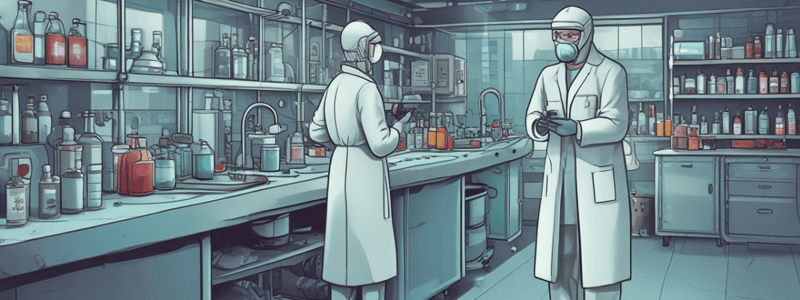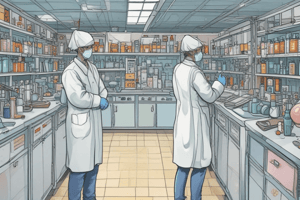Podcast
Questions and Answers
What is laboratory safety and why is it essential?
What is laboratory safety and why is it essential?
Laboratory safety is ensuring the health and safety of workers and researchers in laboratory settings. It is essential to prevent hazardous environments with risks such as chemical spills, fires, explosions, and exposure to hazardous substances.
What is an infection, and what types of microbes can cause it?
What is an infection, and what types of microbes can cause it?
An infection is when a microorganism invades the body, multiplies, and causes injury or disease. The types of microbes that can cause infection include bacteria, fungi, protozoa, and viruses.
What is a pathogen, and what is its role in infection?
What is a pathogen, and what is its role in infection?
A pathogen is a microbe capable of causing disease. It is the infectious agent responsible for causing an infection.
What are the two types of infections, and what is the difference between them?
What are the two types of infections, and what is the difference between them?
What is the chain of infection, and what are its components?
What is the chain of infection, and what are its components?
What is the role of the reservoir in the chain of infection?
What is the role of the reservoir in the chain of infection?
What are the different means of transmission in the chain of infection?
What are the different means of transmission in the chain of infection?
What is the importance of laboratory safety and infection control in healthcare settings?
What is the importance of laboratory safety and infection control in healthcare settings?
What is a biohazard?
What is a biohazard?
What are the routes of exposure to biohazards?
What are the routes of exposure to biohazards?
What is the best defense against hepatitis B virus (HBV)?
What is the best defense against hepatitis B virus (HBV)?
What is the purpose of an Exposure Control Plan?
What is the purpose of an Exposure Control Plan?
How can blood or other body fluids contact the skin and cause exposure to blood-borne pathogens?
How can blood or other body fluids contact the skin and cause exposure to blood-borne pathogens?
What is the first step in responding to a needlestick or other sharps injury?
What is the first step in responding to a needlestick or other sharps injury?
What is a susceptible host?
What is a susceptible host?
What is the primary method of breaking the chain of infection?
What is the primary method of breaking the chain of infection?
What is the purpose of an infection-control program?
What is the purpose of an infection-control program?
What is the correct order for donning personal protective equipment (PPE)?
What is the correct order for donning personal protective equipment (PPE)?
What is the primary purpose of hand hygiene in infection control?
What is the primary purpose of hand hygiene in infection control?
What is the correct order for removing personal protective equipment (PPE)?
What is the correct order for removing personal protective equipment (PPE)?
What should you do if a chemical splash gets into your eyes?
What should you do if a chemical splash gets into your eyes?
What should be done with nonreusable items contaminated with blood or body fluids?
What should be done with nonreusable items contaminated with blood or body fluids?
What are the three elements required for a fire to occur?
What are the three elements required for a fire to occur?
What type of fire requires blocking oxygen or smothering to extinguish?
What type of fire requires blocking oxygen or smothering to extinguish?
What should you do if you experience electrical shock?
What should you do if you experience electrical shock?
What is the purpose of a Material Safety Data Sheet (MSDS)?
What is the purpose of a Material Safety Data Sheet (MSDS)?
What should you do when cleaning up a body fluid spill?
What should you do when cleaning up a body fluid spill?
What is the purpose of a spill cleanup kit?
What is the purpose of a spill cleanup kit?
What should be done if a fire breaks out?
What should be done if a fire breaks out?
What is the primary goal of the OSHA Hazard Communication Standard?
What is the primary goal of the OSHA Hazard Communication Standard?
Flashcards are hidden until you start studying
Study Notes
Laboratory Safety
- Laboratory safety is crucial to ensure the health and safety of workers and researchers in laboratory settings.
- Laboratories can be hazardous environments with potential risks, including chemical spills, fires, explosions, and exposure to hazardous substances.
Infection Control
- Infection: when a microorganism invades the body, multiplies, and causes injury or disease.
- Microbes include bacteria, fungi, protozoa, and viruses.
- Pathogen: a microbe capable of causing disease.
- Types of infections:
- Communicable: able to be spread from person to person.
- Nosocomial and healthcare-associated infections (HAIs): infections acquired in hospitals and other healthcare settings, causing 1.7 million HAIs and 99,000 associated deaths each year.
- Chain of Infection:
- Infectious (causative) agent: pathogenic microbe responsible for causing an infection.
- Reservoir: source of infectious agent, including humans, animals, food, water, soil, and equipment.
- Exit pathway: way an infectious agent leaves a reservoir host, including secretions, exudates, tissue specimens, blood, feces, and urine.
- Means of transmission: airborne, contact, direct, indirect, droplet, vector, and vehicle.
- Entry pathway: way an infectious agent enters a susceptible host, including body orifices, mucous membranes, and breaks in skin.
- Susceptible host: someone with a decreased ability to resist infection, influenced by factors such as age, health, and immune status.
- Breaking the Chain of Infection:
- Hand washing
- Nutrition, rest, and stress reduction
- Immunization
- Insect and rodent control
- Isolation procedures
- Decontamination of surfaces and instruments
- Disposal of sharps and infectious waste
- Use of gloves, gowns, masks, and respirators
- Needle safety devices
- Infection-Control Program:
- Protects patients, employees, visitors, and others.
- Breaks the chain of infection.
- Monitors and collects data on all infections occurring in the institution.
- Institutes special precautions in the event of outbreaks.
- Components: employee screening and immunization, evaluation and treatment, and surveillance.
Biosafety
- Biohazard: any material or substance harmful to health, identified by a biohazard symbol.
- Biohazard exposure routes:
- Airborne
- Ingestion
- Nonintact skin
- Percutaneous (through the skin)
- Permucosal (through mucous membranes)
- Blood-Borne Pathogen (BBP):
- Hepatitis B virus (HBV) and hepatitis D virus.
- Best defense: HBV vaccination.
- HBV exposure hazards: present in blood and other body fluids, can survive up to a week on objects, and transmitted via needlesticks, sexual contact.
- Exposure Control Plan:
- Written and reviewed at least annually.
- Nonmanagerial employees with risk of exposure are involved in identification, review, and selection.
- BBP Exposure Routes:
- Skin pierced by a contaminated needle or sharp object.
- Blood or other body fluid splashes in eyes, nose, or mouth.
- Blood or other body fluid contacts cut, scratch, or abrasion.
- A human bite breaks the skin.
- Exposure Incident Procedure:
- Needlestick or other sharps injury: carefully remove shards of glass or other objects, wash site with soap and water for at least 30 seconds.
- Mucous membrane exposure: flush site with water or sterile saline for at least 10 minutes, use eyewash station if available, and remove contact lenses as soon as possible and disinfect them.
- Report incident to immediate supervisor and provider for evaluation, treatment, and counseling.
Electrical Safety
- Actions to take if electrical shock occurs:
- Shut off the source of electricity.
- Use a nonconducting item to remove the source of electricity from the victim.
- Call for medical assistance.
- Start cardiopulmonary resuscitation if indicated.
- Keep the victim warm.
Fire Safety
- All employees should know:
- Procedures to follow in case of fire.
- Location of fire extinguishers and how to use them.
- Location of fire blankets or heavy towels and how to use them.
- Location of emergency exits and evacuation routes.
- Components needed for fire to occur:
- Fuel: combustible material.
- Heat: raises the temperature of the material until ignition.
- Oxygen: to maintain combustion.
- Chemical reaction: produces fire.
- Keep components apart to prevent fire.
- Classes of Fire:
- Class A: ordinary combustible materials (wood, paper), require water or water-based solutions to extinguish.
- Class B: flammable liquids and vapors (paint, oil, grease, gasoline), require blocking oxygen or smothering to extinguish.
- Class C: electrical equipment, require nonconducting agents to extinguish.
- Class D: combustible or reactive metals (sodium, potassium, magnesium, lithium), require dry powder agents or sand to extinguish.
- Class K: high-temperature cooking oils, grease, or fats, require agents that prevent splashing and cool and smother the fire.
Chemical Safety
- General Rules:
- Always wear PPE.
- Clean up chemical spills properly.
- Never store chemicals above eye level or indiscriminately mix chemicals together.
- Never add water to acid.
- OSHA Hazard Communication (HazCom) Standard:
- HazCom labeling requirements: statement of warning ("danger" or "poison"), statement of hazard (toxic, flammable, combustible), precautions to eliminate risk, and first aid measures for spills or other exposure.
- Material Safety Data Sheets: provide general, precautionary, and emergency information on the product.
- Spill cleanup kit: necessary for cleaning up chemical spills.
Studying That Suits You
Use AI to generate personalized quizzes and flashcards to suit your learning preferences.



